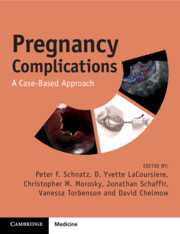Book contents
- Pregnancy Complications
- Pregnancy Complications
- Copyright page
- Contents
- Contributors
- Preface
- Note from the Editor-in-Chief
- Normal Laboratory Values (Conventional Units) []
- Section 1 Antepartum (Early Pregnancy)
- Section 2 Antepartum (Mid-trimester)
- Section 3 Antepartum (Late Pregnancy)
- Section 4 Antepartum (Medical Complications)
- Case 32 A 35-Year-Old Presents at 25 Weeks’ Gestation with Abnormal Glucose Tolerance Testing
- Case 33 A 25-Year-Old Presents at 35 Weeks’ Gestation with Hypertension, Proteinuria, and Seizure
- Case 34 A 25-Year-Old at 32 Weeks’ Gestation with Hypertension and Right Upper Quadrant Pain
- Case 35 A 35-Year-Old Presents at 8 Weeks’ Gestation with Tremor and Exophthalmos
- Case 36 A 23-Year-Old Primigravida at 8 Weeks’ Gestation with Fatigue, Constipation, and Cold Intolerance
- Case 37 A 25-Year-Old with Elevated Hemoglobin A2 on Initial Prenatal Labs
- Case 38 A 30-Year-Old at 10 Weeks’ Gestation with a New Positive HIV Test
- Section 5 Antepartum (Infectious Complications)
- Section 6 Intrapartum/Delivery
- Section 7 Postpartum
- Section 8 Fetal Complications
- Section 9 Placental Complications
- Section 10 Complications of the Cord, Amnion, and Gravid Uterus
- Section 11 Psychosocial Considerations
- Index
- References
Case 38 - A 30-Year-Old at 10 Weeks’ Gestation with a New Positive HIV Test
from Section 4 - Antepartum (Medical Complications)
Published online by Cambridge University Press: aN Invalid Date NaN
- Pregnancy Complications
- Pregnancy Complications
- Copyright page
- Contents
- Contributors
- Preface
- Note from the Editor-in-Chief
- Normal Laboratory Values (Conventional Units) []
- Section 1 Antepartum (Early Pregnancy)
- Section 2 Antepartum (Mid-trimester)
- Section 3 Antepartum (Late Pregnancy)
- Section 4 Antepartum (Medical Complications)
- Case 32 A 35-Year-Old Presents at 25 Weeks’ Gestation with Abnormal Glucose Tolerance Testing
- Case 33 A 25-Year-Old Presents at 35 Weeks’ Gestation with Hypertension, Proteinuria, and Seizure
- Case 34 A 25-Year-Old at 32 Weeks’ Gestation with Hypertension and Right Upper Quadrant Pain
- Case 35 A 35-Year-Old Presents at 8 Weeks’ Gestation with Tremor and Exophthalmos
- Case 36 A 23-Year-Old Primigravida at 8 Weeks’ Gestation with Fatigue, Constipation, and Cold Intolerance
- Case 37 A 25-Year-Old with Elevated Hemoglobin A2 on Initial Prenatal Labs
- Case 38 A 30-Year-Old at 10 Weeks’ Gestation with a New Positive HIV Test
- Section 5 Antepartum (Infectious Complications)
- Section 6 Intrapartum/Delivery
- Section 7 Postpartum
- Section 8 Fetal Complications
- Section 9 Placental Complications
- Section 10 Complications of the Cord, Amnion, and Gravid Uterus
- Section 11 Psychosocial Considerations
- Index
- References
Summary
Caring for patient with HIV in pregnancy requires additional compassion and attention to recent developments. The CDC maintains a website with up-to-date recommendations to guide care. Prognosis for women with HIV in pregnancy is good, with a vertical transmission rate of 0.09% if viral load was <50 copies/mL. In those successfully achieving an undetectable HIV RNA by 36 weeks, cesarean delivery has not been shown to further reduce the vertical transmission risk. Delivery timing for patients with HIV and an undetectable HIV RNA should be per usual obstetric indications and timing. However, if the HIV RNA is >1,000 copies/mL, cesarean delivery prior to labor is performed at 38 weeks. HIV RNA that is detectable, but <1,000 copies/mL should raise concern that there are issues with compliance and patient counseling and repeat testing before 38 weeks should be considered. Oral antiviral medications are continued throughout labor and delivery. Adding intravenous zidovudine at least 3 hours prior to delivery (2 mg/kg load over first hour, then 1 mg/kg/hour until delivery) for patients with HIV RNA >1,000 copies/mL further reduces the risk of transmission. In HIV discordant couples, condoms are recommended during pregnancy. If viral suppression is unable to be maintained, a partner’s HIV status is unknown, or condoms are not able to be negotiated, consider the addition of preexposure prophylaxis with tenofovir/emtricitabine.
Keywords
- Type
- Chapter
- Information
- Pregnancy ComplicationsA Case-Based Approach, pp. 115 - 118Publisher: Cambridge University PressPrint publication year: 2025

